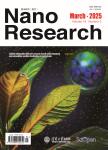Random lasing detection of structural transformation and compositions in silk fibroin scaffolds
在丝绸丝心蛋白脚手架的结构的转变和作文的随机的放射激光察觉作者机构:Department of Mechanical Engineering Yonsei University Yonsei-ro 50 Seodaemun-gu Seoul 03722 Republic of Korea Weldon School of Biomedical Engineering Purdue University West Lafayette Indiana 47907 USA Present address: Center of Bio Microsystems Korea Institute of Science and Technology (KIST) Hwarang-ro Seongbuk-gu Seoul 02792 Republic of Korea School of Electrical Engineering University of Ulsan Daehak-ro Nam-gu Ulsan 44610 Republic of Korea
出 版 物:《Nano Research》 (纳米研究(英文版))
年 卷 期:2019年第12卷第2期
页 面:289-297页
核心收录:
基 金:supported by the research program of the National Research Foundation of Korea (NRF)
主 题:random lasing silk fibroin porous scaffolds aligned pore structure electrospinning hydroxyapatite
摘 要:In tissue engineering, microstructure and material composition of tissue scaffolds have major influences on the proliferation and differentiation of cells in the scaffolds. However, once tissue scaffolds implanted, it is extremely difficult to monitor the change of their microstructure and compositions during tissue regeneration. Here, we report how random lasing can be utilized to non-invasively monitor the structure and composition of scaffolds. We hypothesize that morphological and compositional change of silk fibroin (SF) scaffolds can be conveniently detected based on random lasing responses. Engineered SF scaffolds with hydroxyapatite (HAP) nanoparticles and controlled pore alignment were fabricated, and their random lasing responses were analyzed depending on the concentration of HAP nanoparticles and the degree of,:internal pore alignment. We also examined the real-time random lasing responses of porous SF scaffolds by applying a compressive force to the scaffolds. Introduction of HAP nanoparticles lowered the lasing thresholds and narrowed the random lasing (RL) width dramatically, which :is likely due to the increase in heterogeneity in both refractive index and physical arrangement within the SF and HAP composites. The strong dependency of RL response on pore alignment was also measured and validated by numerical calculation with the finite element method (FEM).Finally, real-time monitoring of RL on compressed scaffolds demonstrated the possibility of using RL as a monitoring tool for structural change of SF scaffolds in vivo.




